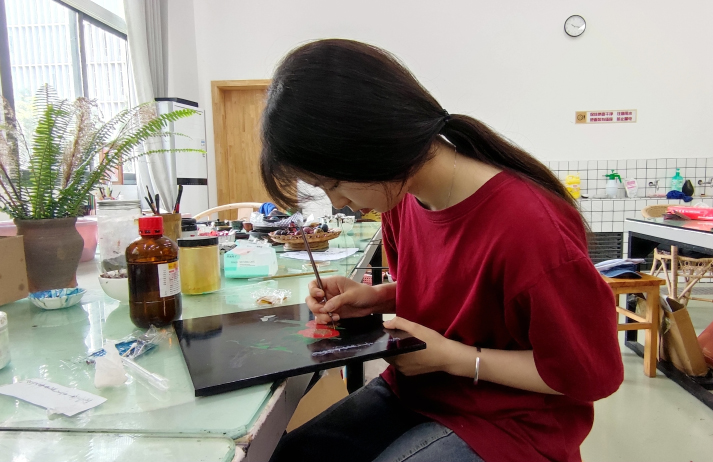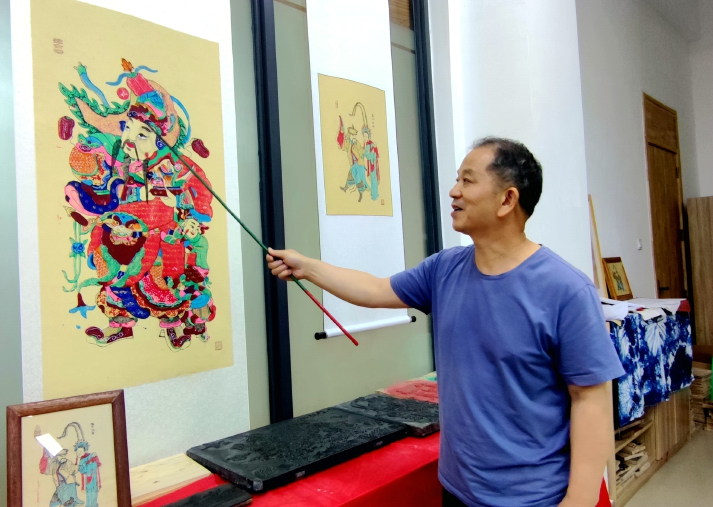| China |
| Chongqing explores ways to make its intangible cultural heritage stand the test of time | |
|
|
 Xiong Yali, a student of lacquer art, creates a painting at the Chongqing Vocational Institute of Tourism in Chongqing on June 9 (LU YAN)
Whenever she immerses herself in creating lacquer artwork, Xiong Yali, a student of the art, gets a sense of inner peace. She has been practicing lacquer art since 2021, when she began a course in it in the Department of Art and Cultural Tourism at the Chongqing Vocational Institute of Tourism in Qianjiang District in Chongqing Municipality. Painted lacquer is very sticky and thus must be applied slowly with a brush, giving rise to thought-out brushstrokes and often elegantly curvilinear designs. Xiong enjoys the art and the mindfulness that accompanies its creation. Dating back more than 3,000 years, to the Shang Dynasty (1600-1046 B.C.), the creation of lacquer art requires dozens of complicated processes. In 2008, Chongqing lacquer decoration art was listed as a form of intangible cultural heritage at the national level. Xiong told Beijing Review she would like to open a studio producing lacquerware after mastering the technique. "But now I have only learned a small fraction of the art. There's still a long way ahead," she said. Chen Qizhi, an inheritor of the lacquer decoration art, a national intangible cultural heritage, and her work (COURTESY PHOTO) For art's sake Generally speaking, producing lacquerware requires making the lacquer from the sap of the lac tree, adding pigments, applying it in multiple layers to an item, and sanding as well as polishing. "A small, exquisite piece of lacquerware can take days or even months to complete, thus requiring both skills and patience from artists," Chen Qizhi, an inheritor of the intangible cultural heritage in Chongqing, told Beijing Review. Chongqing, a mountainous city, is located in the subtropical monsoon climate zone. It is hot in summer and cool in autumn, and generally humid and foggy. These conditions make the municipality a major region for growing quality lac trees, the source of lacquer. In ancient times, lacquerware was not only used in daily life by nobles and royalty, but also used as offerings during sacrifices on important occasions. Since lacquer is almost totally impervious to water, vessels and wine cups have been excavated in perfect condition from waterlogged graves. Coffins, chariots, furniture and other objects found in tombs of the Shang Dynasty were often lacquered, and lacquer was used to fix inlays of shell and colored stone. In modern times, lacquer art has been widely adopted for the production of ornaments, souvenirs, and household items such as cups, vases and plates and furniture. Glossy and smooth, many lacquerware products feature colorful patterns against a black background. In 2020, the Chongqing Vocational Institute of Tourism developed a program to promote the passing on of art and craft-related intangible cultural heritage to boost tourism and creative industries. Chen was one of the many inheritors of these arts to be invited to deliver the courses. While serving as a lecturer at the institute, she also operates her own studio in central Chongqing. It was in the studio that Chen met Xiong. During a visit to Chen's studio at the institute in 2021, Xiong immediately fell in love with the art the first time she saw a lacquered bracelet. After learning more about the art and trying her hand at it, Xiong decided to learn it, hoping to make it her career. "Intangible cultural heritage faces the risk of dying out. We hope that through our program, more young people will learn about and pass on traditional Chinese culture," Tan Jiancheng, head of the institute, told Beijing Review.  Xu Jiahui, who is dedicated to the protection and development of Liangping Woodcut New Year Prints, introduces his work at the Chongqing Vocational Institute of Tourism in Chongqing Municipality on June 9 (LU YAN)
Passing on the legacy Xu Jiahui is another heritage inheritor invited to teach at the institute. Xu has spent his life so far in the protection and development of Liangping Woodcut New Year Prints, a combination of printing and painting which has a history of more than 500 years. The prints are used to decorate homes during the Spring Festival, or Chinese New Year, China's most important festival. Figures from Chinese myths, legends and opera stories are often the subjects of the art form. For example, images of door gods are posted on the outside and inside of the gate to the house to keep evil away, protect the family and invite peace and good fortune. Born in 1966 in Liangping County in Chongqing, Xu began to learn to make New Year prints from his family at 13. One of the distinctive features of Liangping Woodcut New Year Prints is that artists use bright red and green paints to make the figures in the picture stand out. "We put a little blush on their faces, making them look alive," Xu said. Additionally, the use of complex techniques allows the pictures to maintain strong colors that will not fade for hundreds of years. Like many other forms of intangible cultural heritage, the value lies in the skills used to produce the prints. "Handmade means made by people. Handcrafted products feature a unique warmth and temperature and cannot be replaced by products made by machines," Xu said. Well painted and preserved New Year prints are very popular among art lovers. Xu's studio has many regular customers from around the country, and his artworks often sell for thousands of yuan (hundreds of U.S. dollars). In addition to mentoring his apprentices, Xu also often teaches in primary and secondary schools and universities at their invitation, helping students understand and enjoy the making of the New Year prints. As a sixth-generation inheritor of Liangping Woodblock New Year Prints, Xu hopes that the traditional techniques bequeathed by his ancestors will continue to be passed down and be introduced into countless households. Similarly, Chen also works on promoting lacquer artwork to a wider audience. For example, when she attends an art or product exhibition, she prepares an immersive area for visitors to try making a piece of lacquerware or to complete one of the final steps of the process. "They can have fun, learn about the art and gain a sense of satisfaction in the process," she said. Having worked with lacquer for more than three decades, Chen believes that ensuring the livelihoods of artisans is crucial to keeping them engaged in the art form and the passing down of intangible cultural heritage. "The complex procedures make the production cycle quite long. It's very difficult to make a living when first pursuing the career," Chen said. For this reason, she teaches her students how to make more products of high quality within a short period of time. "Of course, they can engage in higher-level artistic creation when they have spare time. But the top priority is turning a profit. This will ensure that those young people can make ends meet," she said. Currently, Chen is planning to connect with more customers, get more orders and then invite her students to join her in the creation of those products. "By learning like this for a couple of years, they can work on their own and start up their own businesses while continuing to pursue their artistic dreams," Chen added. (Reporting from Chongqing Municipality) (Print Edition Title: A Devotion to Art) Copyedited by G.P. Wilson Comments to luyan@cicgamericas.com |
|
||||||||||||||||||||||||||||||
|